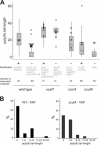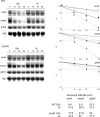CUCU modification of mRNA promotes decapping and transcript degradation in Aspergillus nidulans
- PMID: 19901075
- PMCID: PMC2798463
- DOI: 10.1128/MCB.00997-09
CUCU modification of mRNA promotes decapping and transcript degradation in Aspergillus nidulans
Abstract
In eukaryotes, mRNA decay is generally initiated by the shortening of the poly(A) tail mediated by the major deadenylase complex Ccr4-Caf1-Not. The deadenylated transcript is then rapidly degraded, primarily via the decapping-dependent pathway. Here we report that in Aspergillus nidulans both the Caf1 and Ccr4 orthologues are functionally distinct deadenylases in vivo: Caf1 is required for the regulated degradation of specific transcripts, and Ccr4 is responsible for basal degradation. Intriguingly disruption of the Ccr4-Caf1-Not complex leads to deadenylation-independent decapping. Additionally, decapping is correlated with a novel transcript modification, addition of a CUCU sequence. A member of the nucleotidyltransferase superfamily, CutA, is required for this modification, and its disruption leads to a reduced rate of decapping and subsequent transcript degradation. We propose that 3' modification of adenylated mRNA, which is likely to represent a common eukaryotic process, primes the transcript for decapping and efficient degradation.
Figures





Similar articles
-
Distinct roles for Caf1, Ccr4, Edc3 and CutA in the co-ordination of transcript deadenylation, decapping and P-body formation in Aspergillus nidulans.Mol Microbiol. 2010 Apr;76(2):503-16. doi: 10.1111/j.1365-2958.2010.07118.x. Epub 2010 Mar 10. Mol Microbiol. 2010. PMID: 20233300
-
The deadenylase components Not2p, Not3p, and Not5p promote mRNA decapping.RNA. 2016 May;22(5):709-21. doi: 10.1261/rna.054742.115. Epub 2016 Mar 7. RNA. 2016. PMID: 26952104 Free PMC article.
-
The enzyme activities of Caf1 and Ccr4 are both required for deadenylation by the human Ccr4-Not nuclease module.Biochem J. 2015 Jul 1;469(1):169-76. doi: 10.1042/BJ20150304. Epub 2015 May 6. Biochem J. 2015. PMID: 25944446 Free PMC article.
-
Mechanisms of deadenylation-dependent decay.Wiley Interdiscip Rev RNA. 2011 Mar-Apr;2(2):167-83. doi: 10.1002/wrna.40. Epub 2010 Sep 15. Wiley Interdiscip Rev RNA. 2011. PMID: 21957004 Free PMC article. Review.
-
Regulation of eukaryotic mRNA deadenylation and degradation by the Ccr4-Not complex.Front Cell Dev Biol. 2023 Apr 20;11:1153624. doi: 10.3389/fcell.2023.1153624. eCollection 2023. Front Cell Dev Biol. 2023. PMID: 37152278 Free PMC article. Review.
Cited by
-
Transcriptome analysis of nitrate assimilation in Aspergillus nidulans reveals connections to nitric oxide metabolism.Mol Microbiol. 2010 Nov;78(3):720-38. doi: 10.1111/j.1365-2958.2010.07363.x. Epub 2010 Sep 27. Mol Microbiol. 2010. PMID: 20969648 Free PMC article.
-
The Aspergillus nidulans Pbp1 homolog is required for normal sexual development and secondary metabolism.Fungal Genet Biol. 2017 Mar;100:13-21. doi: 10.1016/j.fgb.2017.01.004. Epub 2017 Jan 9. Fungal Genet Biol. 2017. PMID: 28089630 Free PMC article.
-
Structural insights into a unique preference for 3' terminal guanine of mirtron in Drosophila TUTase tailor.Nucleic Acids Res. 2019 Jan 10;47(1):495-508. doi: 10.1093/nar/gky1116. Nucleic Acids Res. 2019. PMID: 30407553 Free PMC article.
-
The exoribonuclease Dis3L2 defines a novel eukaryotic RNA degradation pathway.EMBO J. 2013 Jul 3;32(13):1842-54. doi: 10.1038/emboj.2013.63. Epub 2013 Mar 15. EMBO J. 2013. PMID: 23503588 Free PMC article.
-
The Dynamic Poly(A) Tail Acts as a Signal Hub in mRNA Metabolism.Cells. 2023 Feb 10;12(4):572. doi: 10.3390/cells12040572. Cells. 2023. PMID: 36831239 Free PMC article.
References
-
- Aebi, M., G. Kirchner, J. Y. Chen, U. Vijayraghavan, A. Jacobson, N. C. Martin, and J. Abelson. 1990. Isolation of a temperature-sensitive mutant with an altered tRNA nucleotidyltransferase and cloning of the gene encoding tRNA nucleotidyltransferase in the yeast Saccharomyces cerevisiae. J. Biol. Chem. 265:16216-16220. - PubMed
Publication types
MeSH terms
Substances
Grants and funding
LinkOut - more resources
Full Text Sources
Molecular Biology Databases
